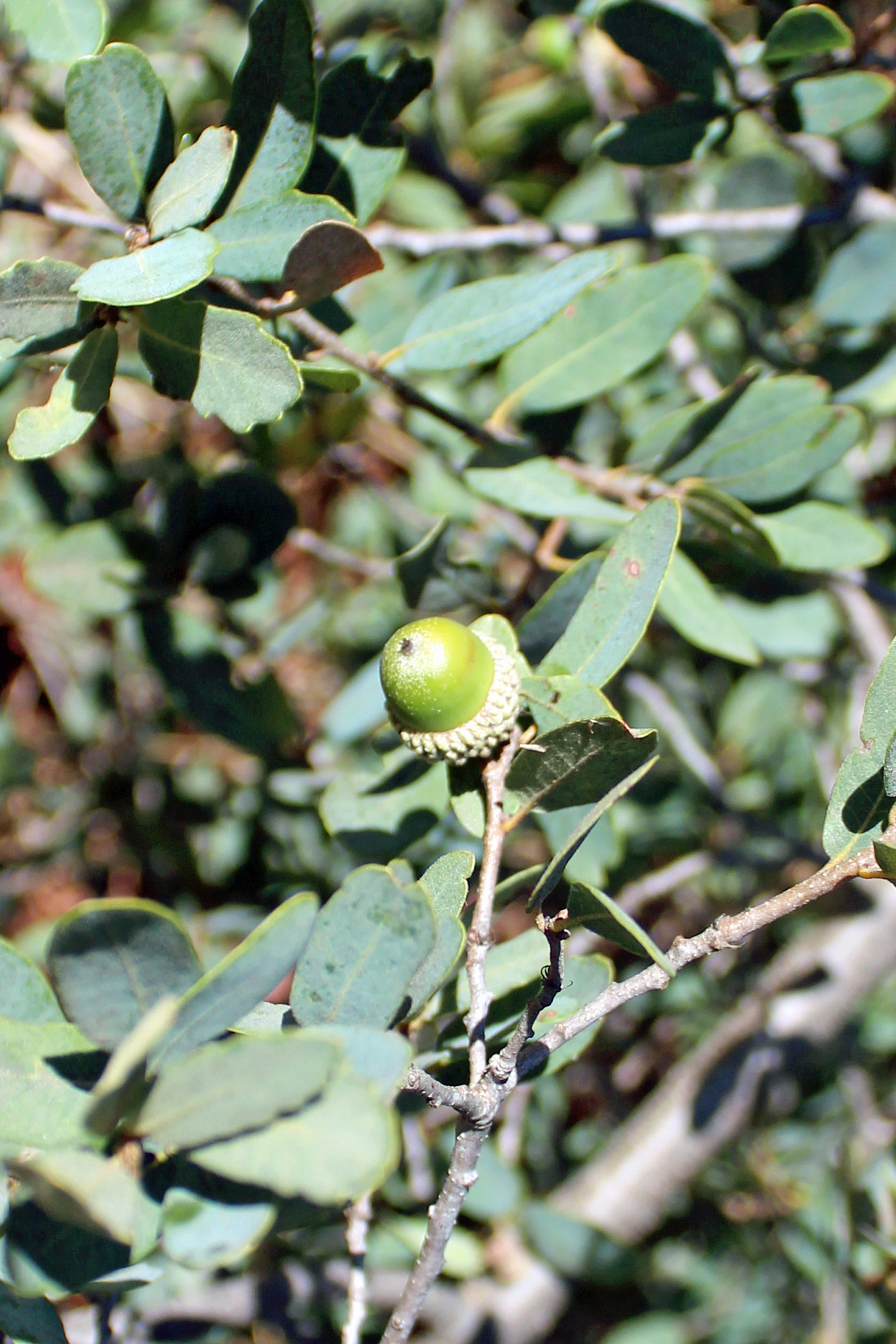Current Distribution Rangewide
Eastern Los Angeles County to northwestern Baja California, Mexico [1]. Smallest distribution of any California oak species.
Known Populations in San Diego County
Forty-six occurrences on Conserved Lands in MUs 3 (Crest-Worley Preserve, Hollenbeck Canyon Wildlife Area, Lawrence and Barbara Daley Preserve, Otay Mountain Ecological Reserve, Otay Mountain Wilderness Area, Otay Ranch Preserve, Sycamore Canyon Preserve, Sycuan Peak Ecological Reserve, Wright's Field), 4 (BLM, Boulder Oaks Preserve, Cleveland National Forest, El Capitan Open Space Preserve, El Capitan Reservoir Open Space, Louis A. Stelzer County Park, Mt. Woodson, Mt. Gower Preserve, SDG&E Sunrise Power Link Parcels, Simon Preserve), 5 (Boden Canyon Ecological Reserve, Cleveland National Forest, Hellhole Canyon Preserve, Ramona Grasslands Preserve, Sutherland Reservoir Open Space), 6 (Daley Ranch Open Space Preserve, Hodges Reservoir Open Space, Lake Wolford, Lake Wolford Watershed), 8 (BLM, Cleveland National Forest, Margarita Peak, Mount Olympus Preserve), 9 (Cleveland National Forest, Santa Ysabel East Open Space), 10 (Cleveland National Forest, Eagle Peak Preserve, Mesa Grande Easement, Santa Ysabel West Open Space Preserve), and 11 (Barrett Reservoir Open Space, Cleveland National Forest, Potrero Park, Sunrise Power Link Parcels).
List Status
None [1].
Habitat Affinities
Chaparral, cismontane woodland, riparian woodland, valley and foothill grassland [2]. Found on mesas with elevation range of 700 -1250 meters [3].
Taxonomy and Genetics
Fagaceae family [2]. Known to hybridize with scrub oak species (Q. cornelius-mulleri, Q. berberidifolia, and Q. durata) [3].
Life History Demography
Semi-deciduous tree [4]. Produces acorns within 1 year [5]. May be better adapted for establishment in more exposed habitats than Q. agrifolia because it is less sensitive to moisture loss, will germinate with little or no additional water uptake, is self-rooting, and has delayed shoot development.
Seasonal Phenology
Bloom period March-June [2]. Acorn drop occurs September-November [5].
Pollination Seed Dispersal
Wind-pollinated [3]. No persistent seed bank since acorns do not survive more than 1 year [5].
Threats
Development [2] and lack of natural recruitment due to grazing [4]. Competition for underground resources between oak seedlings and exotic grasses.
Special Considerations:
As a white oak, it is at low risk from Goldspotted Oak Borer (Agrilus auroguttatus) [1]. Poor host plant for grasshoppers [4].
Literature Sources
[1] Drennen, K. L. 2011. “Western Riverside County Multiple Species Habitat Conservation Plan ( MSHCP ) Biological Monitoring Program Engelmann Oak ( Quercus Engelmannii ) Survey Report 2005.†Riverside, CA.
[2] CNPS, Rare Plant Program. 2016. Inventory of Rare and Endangered Plants (online edition, v8-02). California Native Plant Society, Sacramento, CA. http://www.rareplants.cnps.org, accessed 12 September 2016.
[3] Ortego, J., E. C. Riordan, P. F. Gugger, and V. L. Sork. 2012. “Influence of Environmental Heterogeneity on Genetic Diversity and Structure in an Endemic Southern Californian Oak.†Molecular Ecology 21 (13): 3210–23. doi:10.1111/j.1365-294X.2012.05591.x.
[4] Dunning, C. E., R. A. Redak, and T. D. Paine. 2003. “Preference and Performance of a Generalist Insect Herbivore on Quercus Agrifolia and Quercus Engelmannii Seedlings from a Southern California Oak Woodland.†Forest Ecology and Management 174: 593–603. doi:10.1016/S0378-1127(02)00187-1.
[5] Tyler, C. M., B. Kuhn, and F. W. Davis. 2006. “Demography and Recruitment Limitations of Three Oak Species in California.†The Quarterly Review of Biology 81 (2): 127–52. doi:10.1086/506025.
[6] Snow, G E. 1991. “Germination Characteristics of Engelmann Oak and Coast Live Oak from the Santa Rosa Plateau, Riverside County, California.†Vol. USDA Forest.
